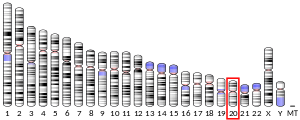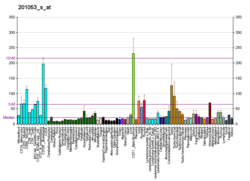PSMF1
Proteasome inhibitor PI31 subunit is a protein that in humans is encoded by the PSMF1 gene.[5][6]
Function
The 26S proteasome is a multicatalytic proteinase complex with a highly ordered structure composed of 2 complexes, a 20S core and a 19S regulator. The 20S core is composed of 4 rings of 28 non-identical subunits; 2 rings are composed of 7 alpha subunits and 2 rings are composed of 7 beta subunits. The 19S regulator is composed of a base, which contains 6 ATPase subunits and 2 non-ATPase subunits, and a lid, which contains up to 10 non-ATPase subunits. Proteasomes are distributed throughout eukaryotic cells at a high concentration and cleave peptides in an ATP/ubiquitin-dependent process in a non-lysosomal pathway. An essential function of a modified proteasome, the immunoproteasome, is the processing of class I MHC peptides. This gene encodes a protein that inhibits the activation of the proteasome by the 11S and 19S regulators. Alternative transcript variants have been identified for this gene.[6]
References
- GRCh38: Ensembl release 89: ENSG00000125818 - Ensembl, May 2017
- GRCm38: Ensembl release 89: ENSMUSG00000032869 - Ensembl, May 2017
- "Human PubMed Reference:". National Center for Biotechnology Information, U.S. National Library of Medicine.
- "Mouse PubMed Reference:". National Center for Biotechnology Information, U.S. National Library of Medicine.
- Tanahashi N, Kawahara H, Murakami Y, Tanaka K (Apr 1999). "The proteasome-dependent proteolytic system". Molecular Biology Reports. 26 (1–2): 3–9. doi:10.1023/A:1006909522731. PMID 10363639.
- "Entrez Gene: PSMF1 proteasome (prosome, macropain) inhibitor subunit 1 (PI31)".
Further reading
- Goff SP (Aug 2003). "Death by deamination: a novel host restriction system for HIV-1". Cell. 114 (3): 281–3. doi:10.1016/S0092-8674(03)00602-0. PMID 12914693.
- Minghetti L, Visentin S, Patrizio M, Franchini L, Ajmone-Cat MA, Levi G (May 2004). "Multiple actions of the human immunodeficiency virus type-1 Tat protein on microglial cell functions". Neurochemical Research. 29 (5): 965–78. doi:10.1023/B:NERE.0000021241.90133.89. PMID 15139295.
- Liou LY, Herrmann CH, Rice AP (Sep 2004). "HIV-1 infection and regulation of Tat function in macrophages". The International Journal of Biochemistry & Cell Biology. 36 (9): 1767–75. doi:10.1016/j.biocel.2004.02.018. PMID 15183343.
- Bannwarth S, Gatignol A (Jan 2005). "HIV-1 TAR RNA: the target of molecular interactions between the virus and its host". Current HIV Research. 3 (1): 61–71. doi:10.2174/1570162052772924. PMID 15638724.
- Gibellini D, Vitone F, Schiavone P, Re MC (Apr 2005). "HIV-1 tat protein and cell proliferation and survival: a brief review". The New Microbiologica. 28 (2): 95–109. PMID 16035254.
- Hetzer C, Dormeyer W, Schnölzer M, Ott M (Oct 2005). "Decoding Tat: the biology of HIV Tat posttranslational modifications". Microbes and Infection / Institut Pasteur. 7 (13): 1364–9. doi:10.1016/j.micinf.2005.06.003. PMID 16046164.
- Peruzzi F (2006). "The multiple functions of HIV-1 Tat: proliferation versus apoptosis". Frontiers in Bioscience. 11: 708–17. doi:10.2741/1829. PMID 16146763.
- Andersson B, Wentland MA, Ricafrente JY, Liu W, Gibbs RA (Apr 1996). "A "double adaptor" method for improved shotgun library construction". Analytical Biochemistry. 236 (1): 107–13. doi:10.1006/abio.1996.0138. PMID 8619474.
- Seeger M, Ferrell K, Frank R, Dubiel W (Mar 1997). "HIV-1 tat inhibits the 20 S proteasome and its 11 S regulator-mediated activation". The Journal of Biological Chemistry. 272 (13): 8145–8. doi:10.1074/jbc.272.13.8145. PMID 9079628.
- Yu W, Andersson B, Worley KC, Muzny DM, Ding Y, Liu W, Ricafrente JY, Wentland MA, Lennon G, Gibbs RA (Apr 1997). "Large-scale concatenation cDNA sequencing". Genome Research. 7 (4): 353–8. doi:10.1101/gr.7.4.353. PMC 139146. PMID 9110174.
- Madani N, Kabat D (Dec 1998). "An endogenous inhibitor of human immunodeficiency virus in human lymphocytes is overcome by the viral Vif protein". Journal of Virology. 72 (12): 10251–5. PMC 110608. PMID 9811770.
- Simon JH, Gaddis NC, Fouchier RA, Malim MH (Dec 1998). "Evidence for a newly discovered cellular anti-HIV-1 phenotype". Nature Medicine. 4 (12): 1397–400. doi:10.1038/3987. PMID 9846577.
- McCutchen-Maloney SL, Matsuda K, Shimbara N, Binns DD, Tanaka K, Slaughter CA, DeMartino GN (Jun 2000). "cDNA cloning, expression, and functional characterization of PI31, a proline-rich inhibitor of the proteasome". The Journal of Biological Chemistry. 275 (24): 18557–65. doi:10.1074/jbc.M001697200. PMID 10764772.
- Mulder LC, Muesing MA (Sep 2000). "Degradation of HIV-1 integrase by the N-end rule pathway". The Journal of Biological Chemistry. 275 (38): 29749–53. doi:10.1074/jbc.M004670200. PMID 10893419.
- Sheehy AM, Gaddis NC, Choi JD, Malim MH (Aug 2002). "Isolation of a human gene that inhibits HIV-1 infection and is suppressed by the viral Vif protein". Nature. 418 (6898): 646–50. Bibcode:2002Natur.418..646S. doi:10.1038/nature00939. PMID 12167863.
- Zaiss DM, Standera S, Kloetzel PM, Sijts AJ (Oct 2002). "PI31 is a modulator of proteasome formation and antigen processing". Proceedings of the National Academy of Sciences of the United States of America. 99 (22): 14344–9. Bibcode:2002PNAS...9914344Z. doi:10.1073/pnas.212257299. PMC 137886. PMID 12374861.
- Huang X, Seifert U, Salzmann U, Henklein P, Preissner R, Henke W, Sijts AJ, Kloetzel PM, Dubiel W (Nov 2002). "The RTP site shared by the HIV-1 Tat protein and the 11S regulator subunit alpha is crucial for their effects on proteasome function including antigen processing". Journal of Molecular Biology. 323 (4): 771–82. doi:10.1016/S0022-2836(02)00998-1. PMID 12419264.





